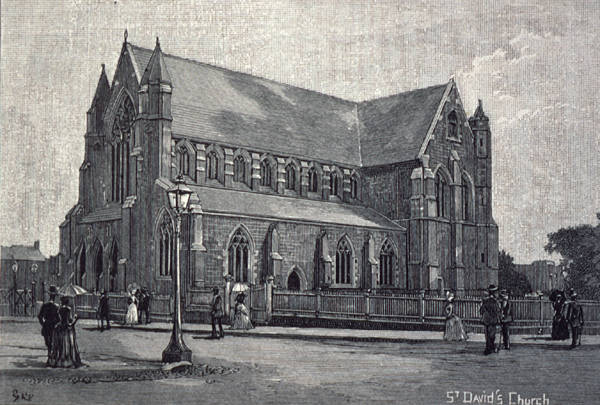 |
 |
Anglicanism
Anglicanism has remained the largest Christian denomination in Tasmania during two centuries of European settlement, and despite a steady decline in active membership since the 1960s, the 2001 census revealed that nearly one third of Tasmanians still identified as Anglicans, well above the national proportion (20.7 percent). Nevertheless, a 1996 survey indicated that 50 percent of regular church-goers were aged over sixty. For the first half of the nineteenth century the Church of England was treated by government as the colony's official though not 'established' religion. Robert Knopwood, the first colonial chaplain, carried responsibility for the spiritual oversight of the entire colony until the appointment of a Launceston-based chaplain in 1818. The senior chaplain served on the Executive Council and the later-established Legislative Council. Van Diemen's Land was episcopally directed from the diocese of Calcutta between 1814 and 1835, when it became part of the new Diocese of Australia, led by the Sydney-based Bishop William Broughton. With the appointment of FR Nixon as first Bishop of Tasmania in 1842, St David's Church was elevated to cathedral status and Hobart Town proclaimed a city. The Church's legal framework had been set by the Church Act (of New South Wales) in 1837, but provision for synodical governance was not made until 1858, with passage of the Church of England Constitution Bill by Tasmania's parliament. The Tasmanian Church remained an extension of the English Church until 1962, when a national constitution was adopted.
With government assistance many fine church buildings were constructed during the 1830s and 1840s, and by 1862, 41 parishes had been created. A new gothic-revival St David's Cathedral, designed by GF Bodley, was commenced in 1868. Establishment of a Board of Education for the colony in 1839 had meant the loss of the Church of England assisted monopoly over the provision of elementary education, but both Nixon and Lt-Governor Franklin energetically promoted secondary education. Launceston Church Grammar School and the Hutchins School in Hobart opened in 1846. In that year Christ College began its chequered history as a venture into tertiary education. Girls' schools followed several decades later – Broadlands House in 1882 and St Michael's Collegiate in 1892. The Church in Tasmania may have been more effective in ministering to convicts than in New South Wales, notwithstanding Nixon's resentment of government control of chaplaincy appointments. The Church contributed little, however, to the welfare of the Aboriginal population during and following the period of violent conflict with white landowners in the 1820s and 1830s. This failure owed much to the fact that the overwhelming majority of prominent landowners were Anglicans. In the latter part of the nineteenth century a few leading clergy, including the vigorous but sometimes misguided missionary-minded bishop, HH Montgomery (1889–1901), tried to assist Aborigines in the Bass Strait islands, but for most of the next hundred years Anglicans were generally uninterested in the plight of indigenes. (See also Aboriginal missions.) For much of the twentieth century the Anglican Church in Tasmania remained closely identified with conservative social and political values, though a few church leaders adopted radical public stances on social justice or international issues. Bishop JE Mercer (1902–14) preached Christian socialism and exerted some influence on the young Australian Labor Party, while the state's eighth bishop, GF Cranswick (1943–62), espoused several unpopular causes, including 'friendship' with the Soviet Union and Communist China. New Church-sponsored welfare institutions appeared in the second half of the twentieth century. The diocese relinquished St John's Hospital in 1984 but it opened several retirement complexes, and in 1983 launched Anglicare, a community welfare agency, which by 2003 was expending nearly $14 million (approximately 60 percent from state government sources), employing some 400 staff and vigorously advocating measures to alleviate poverty. Declining church attendances and rising costs posed acute problems for the Tasmanian Church from the late 1980s, compounded by the burden of maintaining its many historic buildings. Thus began the painful process of rationalising parish boundaries and clergy resources. The eleventh bishop, John Harrower (2000–), designated the Tasmanian Church a 'missionary diocese' and experimented with ordinations of non-stipendiary priests granted area-specific licences. Anglicanism's public standing and collective self-confidence suffered from a series of sex abuse complaints against clergy from the mid-1990s, and a Church-appointed inquiry reported publicly in 1998. Synod established complaints and discipline procedures, while part of the proceeds from the sale of Bishopscourt, the episcopal residence since 1865, was earmarked for a fund to assist abuse victims. Tasmanian Anglicanism has never been captured by a single tradition of churchmanship, but disputes between Anglo-Catholics and Evangelicals were not uncommon in the nineteenth century, and efficient administration of the diocese has been perpetually compromised by regional loyalties dividing north and south. Further reading: J Boyce, God's own country?, Hobart 2001; Christian Research Association, 'Profile of the Diocese of Tasmania', 2001; G Stephens, The Anglican Church in Tasmania, Hobart, 1991. Peter Boyce |
Copyright 2006, Centre for Tasmanian Historical Studies |

